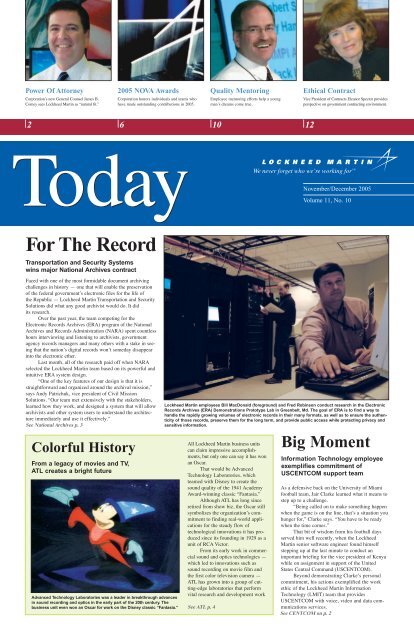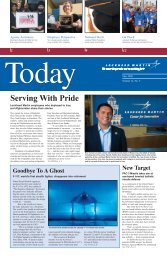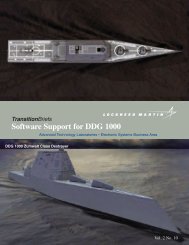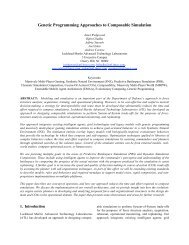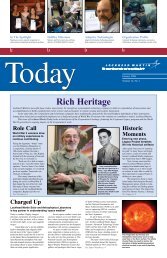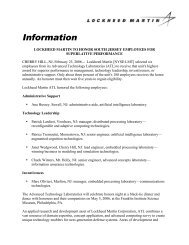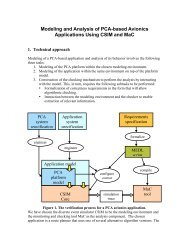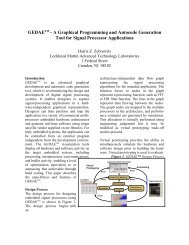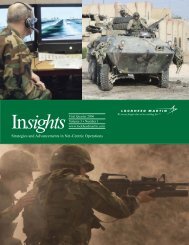For The Record - Lockheed Martin Advanced Technology Laboratories
For The Record - Lockheed Martin Advanced Technology Laboratories
For The Record - Lockheed Martin Advanced Technology Laboratories
You also want an ePaper? Increase the reach of your titles
YUMPU automatically turns print PDFs into web optimized ePapers that Google loves.
Power Of AttorneyCorporation’s new General Counsel James B.Comey sees <strong>Lockheed</strong> <strong>Martin</strong> as “natural fit.”2005 NOVA AwardsCorporation honors individuals and teams whohave made outstanding contributions in 2005.Quality MentoringEmployee mentoring efforts help a youngman’s dreams come true.Ethical ContractVice President of Contracts Eleanor Spector providesperspective on government contracting environment.261012November/December 2005Volume 11, No. 10<strong>For</strong> <strong>The</strong> <strong>Record</strong>Transportation and Security Systemswins major National Archives contractFaced with one of the most formidable document archivingchallenges in history — one that will enable the preservationof the federal government’s electronic files for the life ofthe Republic — <strong>Lockheed</strong> <strong>Martin</strong> Transportation and SecuritySolutions did what any good archivist would do. It didits research.Over the past year, the team competing for theElectronic <strong>Record</strong>s Archives (ERA) program of the NationalArchives and <strong>Record</strong>s Administration (NARA) spent countlesshours interviewing and listening to archivists, governmentagency records managers and many others with a stake in seeingthat the nation’s digital records won’t someday disappearinto the electronic ether.Last month, all of the research paid off when NARAselected the <strong>Lockheed</strong> <strong>Martin</strong> team based on its powerful andintuitive ERA system design.“One of the key features of our design is that it isstraightforward and organized around the archival mission,”says Andy Patrichuk, vice president of Civil MissionSolutions. “Our team met extensively with the stakeholders,learned how they work, and designed a system that will allowarchivists and other system users to understand the architectureimmediately and use it effectively.”See National Archives p. 3Colorful HistoryFrom a legacy of movies and TV,ATL creates a bright future<strong>Advanced</strong> <strong>Technology</strong> <strong>Laboratories</strong> was a leader in breakthrough advancesin sound recording and optics in the early part of the 20th century. <strong>The</strong>business unit even won an Oscar for work on the Disney classic “Fantasia.”<strong>Lockheed</strong> <strong>Martin</strong> employees Bill MacDonald (foreground) and Fred Robinson conduct research in the Electronic<strong>Record</strong>s Archives (ERA) Demonstrations Prototype Lab in Greenbelt, Md. <strong>The</strong> goal of ERA is to find a way tohandle the rapidly growing volumes of electronic records in their many formats, as well as to ensure the authenticityof those records, preserve them for the long term, and provide public access while protecting privacy andsensitive information.All <strong>Lockheed</strong> <strong>Martin</strong> business unitscan claim impressive accomplishments,but only one can say it has wonan Oscar.That would be <strong>Advanced</strong><strong>Technology</strong> <strong>Laboratories</strong>, whichteamed with Disney to create thesound quality of the 1941 AcademyAward-winning classic “Fantasia.”Although ATL has long sinceretired from show biz, the Oscar stillsymbolizes the organization’s commitmentto finding real-world applicationsfor the steady flow oftechnological innovations it has producedsince its founding in 1929 as aunit of RCA Victor.From its early work in commercialsound and optics technologies —which led to innovations such assound recording on movie film andthe first color television camera —ATL has grown into a group of cutting-edgelaboratories that performvital research and development workSee ATL p. 4Big MomentInformation <strong>Technology</strong> employeeexemplifies commitment ofUSCENTCOM support teamAs a defensive back on the University of Miamifootball team, Jair Clarke learned what it means tostep up to a challenge.“Being called on to make something happenwhen the game is on the line, that’s a situation youhunger for,” Clarke says. “You have to be readywhen the time comes.”That bit of wisdom from his football daysserved him well recently, when the <strong>Lockheed</strong><strong>Martin</strong> senior software engineer found himselfstepping up at the last minute to conduct animportant briefing for the vice president of Kenyawhile on assignment in support of the UnitedStates Central Command (USCENTCOM).Beyond demonstrating Clarke’s personalcommitment, his actions exemplified the workethic of the <strong>Lockheed</strong> <strong>Martin</strong> Information<strong>Technology</strong> (LMIT) team that providesUSCENTCOM with voice, video and data communicationsservices.See CENTCOM on p. 2
<strong>Advanced</strong> <strong>Technology</strong> <strong>Laboratories</strong> can trace its history back to a war-surplus tent where researchers conducted field tests in Riverhead, Long Island, N.Y., in 1929. In the photo,from left, are Harold Beverage, Harold Olson, Chester Rice, Edward Kellogg and Ralph Greenman. Kellogg became the first director of ATL.ATLContinued from p. 1<strong>Advanced</strong> <strong>Technology</strong> <strong>Laboratories</strong> was a research leader in optics and sound technology that would eventually make possible modernfilms and color television. Here, from left, Larry Sachtleben and Ed Hutto observe an experiment to determine the power oftransmitted radiant energy in 1955. Sachtleben was granted more than 45 patents while at ATL. Hutto was also present at the ATL 75thanniversary. (inset photo) Ed Hutto, left, is shown here at the <strong>Advanced</strong> <strong>Technology</strong> <strong>Laboratories</strong> 75th anniversary, with Fred Barnum, authorof “His Master’s Voice in America” and a speaker at the celebration.for a wide range of <strong>Lockheed</strong> <strong>Martin</strong>companies and defense customers.This year, ATL employees celebratedthe organization’s 75th anniversaryand reflected on the colorful historythat has enabled ATL to continuallyevolve and endure as both a businesssuccess and a technology leader.“I believe our people here representthe best combination of entrepreneurialspirit and scientific andengineering knowledge,” says JimMarsh, ATL’s director. “<strong>The</strong>y’re able todelve deep into the underlying technologyand find ways to put new advancesto work for our customers.”That combination has been in evidencethroughout the history of ATL,which can trace its beginnings toGeneral Electric’s famed laboratory inSchenectady, N.Y.A part of the Schenectady grouptransferred to RCA Victor in Camden,N.J., where the Photophone DevelopmentGroup’s first leader, Edward Kellogg, setthe tone of technical excellence and intellectualcuriosity that remains with thelaboratories to this day.“<strong>The</strong> engineers were alwaysbouncing ideas off of each other, andeverybody knew everybody,” recallsHank Haynes, who came to work forKellogg in Camden in 1941.But Haynes adds that while thecollegial atmosphere encouraged takingrisks and pursuing new ideas, there wasalso a strong focus on practicality. <strong>The</strong>organization emphasized obtainingpatents, for example, to protect intellectualproperty and as a symbol of RCA’stechnological leadership.One of the organization’s biggestinnovations of the early years had nothingto do with technology but neverthelessrepresented a significant event inengineering history. That was the initiationof the RCA Cadettes program,which brought 137 women to work intechnical positions during the war years.One of the Cadets was Haynes’sfuture wife, Caryl. “<strong>The</strong>re were veryfew women in engineering in thosedays,” she says. “It was a very exciting4
75 Years OfInnovation1929: RCA Victor forms thePhotophone Development Group, theheritage organization of today’s<strong>Advanced</strong> <strong>Technology</strong> <strong>Laboratories</strong>.1937: Develops dichroic mirrors, amajor optical advance that eventuallyenabled the development of thecolor television camera.1941: Wins Academy Award forwork in advancement of sound forDisney’s “Fantasia.”1943: Launches RCA Cadettesprogram, encouraging women topursue careers in engineering.1950: Contributes to development ofoptical system for first commercialcolor television camera.1952: Develops television projectorthat allows broadcasting ofmotion picture film on television.Employees view historic memorabilia, including old patent applications, engineering notebooks, badges and pictures during <strong>Advanced</strong><strong>Technology</strong> <strong>Laboratories</strong> anniversary week.time. Our group was like a family, andthe work was very challenging.”Caryl eventually left the company,but other RCA Cadets stayed with theorganization for many years. One ofthose was Genevieve (Gene) Allee, whowas a prominent contributor to many ofRCA’s patented technologies.During the 75th anniversary celebrationin September, Allee was featuredin a Philadelphia Inquirer newspaperarticle, in which she reflected on 42years with ATL.“<strong>The</strong>re's a lot of women engineersnow, more than there were in the mid-1940s,” she told the newspaper. “<strong>The</strong>war did that. It created opportunitiesfor women.”<strong>For</strong> men and women alike, theopportunity to work on leading-edgetechnologies during RCA’s “golden era”was a rewarding experience.“It was nice to be associated withpeople who made unique contributionsto radio and television,” says Ed Hutto,who went to work for ATL in 1953 andretired in 1983. In addition to workingon radio and television technologies, healso was involved in space initiativesand classified programs.Hutto remembers usingPhiladelphia’s landmark Walt WhitmanBridge — which he watched being builtfrom his office window — as the subjectfor testing the optics on a camera beingdeveloped for use on U.S. space satellites.Like all long-time ATL employees,Hutto witnessed an astounding era oftechnological advancement in which themost profound changes were broughtabout by the introduction of computers.Since 1977, when Mike Stebniskycame to work for ATL, the laboratories’work in software engineering has gonefrom about 20 percent to close to 90percent, he estimates.Stebnisky, a principal member ofthe engineering staff, notes that thedigital explosion is reflected in the organization’sstructure, which today includesfour specialized laboratories — theArtificial Intelligence Laboratory, theDistributed Processing Laboratory, theEmbedded Processing Laboratory, and the<strong>Advanced</strong> Concepts Laboratory — as<strong>The</strong> RCA Cadettes program encouraged women to pursue careers in engineering. Here,from left, are Cadettes Jean Pace, Marian <strong>For</strong>ner, and Amy Lee Clark with an unidentifiedinstructor.“We’re at the forefront of many areas in the world ofinformation technology, and we have a lot to offer our<strong>Lockheed</strong> <strong>Martin</strong> partners. We want everyone to know thatour present and our future are as exciting as our heritage.”well as a Software <strong>Technology</strong> Initiative.Still, he says, the key to the organization’ssuccess remains the same. “Wehave good people who understand whatthe customer needs and are able to deliverwhat they promise,” Stebnisky says.That strength has been especiallyimportant in recent years, as ATL hasincreased its alignment with other<strong>Lockheed</strong> <strong>Martin</strong> business units, servingas a resource and partner on many of theCorporation’s most-successful programs,such as the F-35 Joint StrikeFighter and the AEGIS naval combatsystem. <strong>The</strong> company’s primary outsidecustomer is the Defense <strong>Advanced</strong>Research Projects Agency.Within the Electronic SystemsBusiness Area, ATL functions as a focalpoint and coordinator for research anddevelopment efforts taking place atcompanies throughout the business area.Director Marsh is hoping that companiesacross the Electronic Systemsbusiness area and the entire Corporationwill come to ATL more frequently forhelp in tackling their toughest technologychallenges in areas including trusted networkand network-centric technologies,cognitive computing, autonomous collaborativesystems, virtual prototyping, andpredictive simulation, to name a few.“We’re at the forefront of manyareas in the world of information technology,and we have a lot to offer our<strong>Lockheed</strong> <strong>Martin</strong> partners,” Marsh says.“We want everyone to know that ourpresent and our future are as exciting asour heritage.” ■<strong>For</strong> more information about <strong>Advanced</strong><strong>Technology</strong> <strong>Laboratories</strong>’ history andits modern capabilities, contactStephen O’Neill at (856) 792-9815. <strong>For</strong> moreabout ATL’s role in <strong>Lockheed</strong> <strong>Martin</strong>’sresearch and development structure, see“IRADical Concepts” in <strong>Lockheed</strong> <strong>Martin</strong>Today, May 2005.1955: Delivers first transistorizedmicrophone preamplifier for U.S.Air <strong>For</strong>ce.1959: Designs and builds videorecorder that tapes underside of polarice cap from aboard USS Seadragon.1962: Pioneers use of computersin laying out complex integratedcircuits.1965: Provides hand-held laservoice communicator for Gemini 7mission, resulting in first opticalcommunications from space.1967: Develops first fully automatedplacement and routing softwarefor integrated circuits.1972: Patents optical bowling pindetector.1975: Develops processor that runs8 million instructions per second.1984: Develops solid-state scannersfor Earth resources satellites(LAND-SAT).1985: Creates optical disc “jukebox”to solve data storage andretrieval problems for NASA.1985: Works on software that willallow speech-recognition systemsto accommodate variations in pronunciationand accents.1987: Wins contract from NASA’sJet Propulsion Laboratory for teleroboticssubsystems using artificialintelligence.1993: Produces tactical and cognitivedecision aids for attack andreconnaissance helicopters.1995: Becomes one of the first laboratoriesto embrace intelligent-agenttechnologies, leading to severalbreakthrough defense systems.2000: Begins work on F-35 JointStrike Fighter integrated coreprocessor.2005: <strong>For</strong> Produces more information Human about Alerting KiyoInterruption Tomiyasu’s Logistics career, contact technology to<strong>Lockheed</strong> <strong>Martin</strong> Integratedgreatly improve efficiency of operators610-354-4064.on Aegis ships.Systems & Solutions communicator BradWolf ■5


